
Earl of Warwick is one of the most prestigious titles in the peerages of the United Kingdom. The title has been created four times in English history, and the name refers to Warwick Castle and the town of Warwick.

Earl of Westmorland is a title that has been created twice in the Peerage of England. The title was first created in 1397 for Ralph Neville. It was forfeited in 1571 by Charles Neville, 6th Earl of Westmorland, for leading the Rising of the North. It was revived in 1624 in favour of Sir Francis Fane, whose mother, Mary Neville, was a descendant of a younger son of the first Earl. The first Earl of the first creation had already become Baron Neville de Raby, and that was a subsidiary title for his successors. The current Earl holds the subsidiary title Baron Burghersh (1624).
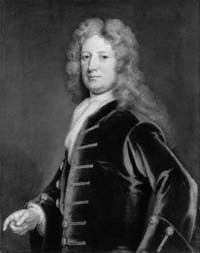
Baron Wharton is a title in the Peerage of England, originally granted by letters patent to the heirs male of the 1st Baron, which was forfeited in 1729 when the last male-line heir was declared an outlaw. The Barony was erroneously revived in 1916 by writ of summons, thanks to an 1844 decision in the House of Lords based on absence of documentation. As such, the current Barony of Wharton could more accurately be listed as a new Barony, created in 1916, with the precedence of the older Barony.

Baron Berners is a barony created by writ in the Peerage of England.

Baron le Despencer is a title that has been created several times by writ in the Peerage of England.
The title Baron Bergavenny was created several times in the Peerage of England and once in the Peerage of Great Britain, all but the first being baronies created by error. Abergavenny is a market town in South East Wales with a castle established by the Norman lord Hamelin de Balun c. 1087.

Edmund Mortimer, 2nd Baron Mortimer of Wigmore was the second son and eventual heir of Roger Mortimer, 1st Baron Mortimer of Wigmore. His mother was Maud de Braose.
William Mauduit, 8th Earl of Warwick or William Maudit was an English nobleman and participant in the Second Barons' War.
The title Baron Monthermer was created twice in the Peerage of England.
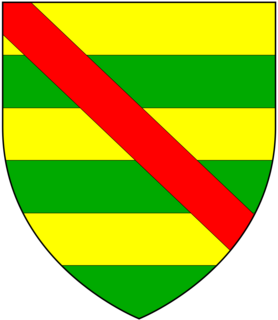
The title of Baron Poynings was created twice in the Peerage of England.

Edward Neville, de facto 3rd Baron Bergavenny was an English nobleman.
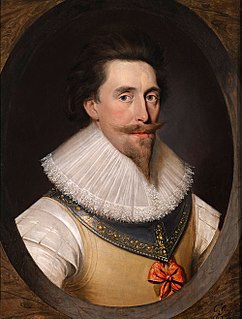
Francis Fane, 1st Earl of Westmorland, of Mereworth in Kent and of Apethorpe in Northamptonshire was an English landowner and politician who sat in the House of Commons between 1601 and 1624 and then was raised to the Peerage as Earl of Westmorland.

Edward le Despenser, 1st Baron Despenser was the son of another Edward le Despenser and Anne Ferrers, sister of Henry, Lord Ferrers of Groby. He succeeded as Lord of Glamorgan in 1349.
Frances Neville, Baroness Bergavenny (also Nevill was an English noblewoman and author. Little is known of either Lady or Lord Bergavenny, except that the latter was accused of behaving in a riotous and unclean manner by some Puritan commentators. Lady Bergavenny's work appeared in The Monument of Matrones in 1582 and was a series of "Praiers". Her devotions were sixty-seven prose prayers, one metrical prayer against vice, a long acrostic prayer on her daughter's name, and an acrostic prayer containing her own name.
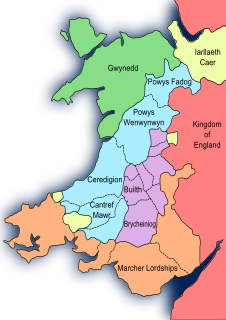
The Lordship of Glamorgan was one of the most powerful and wealthy of the Welsh Marcher Lordships. The seat was Cardiff Castle. It was established by the conquest of Glamorgan from its native Welsh ruler, by the Anglo-Norman nobleman Robert FitzHamon, feudal baron of Gloucester, and his legendary followers the Twelve Knights of Glamorgan. The Anglo-Norman Lord of Glamorgan, like all Marcher lords, ruled his lands directly by his own law: thus he could, amongst other things, declare war, raise taxes, establish courts and markets and build castles as he wished, without reference to the Crown. These privileges were only lost under the Laws in Wales Acts 1535–1542. Though possessing many castles, the main seat of the Lordship was Cardiff Castle.
Elizabeth Despencer, 3rd Baroness Burghersh was an English noblewoman born to Bartholomew de Burghersh, 2nd Baron Burghersh and Cicely Weyland.
Elizabeth Beauchamp, Baroness (A)Bergavenny was a medieval English noblewoman and heiress. She was the only child of Richard de Beauchamp, Baron Abergavenny and Earl of Worcester, by Isabel, daughter of Thomas le Despenser, Earl of Gloucester by Constance of York, granddaughter of Edward III.

Thomas Fane of Badsell Manor in the parish of Tudeley in Kent, and of Mereworth Castle, Kent, was Sheriff of Kent. He is not to be confused with his younger brother, Thomas Fane, of Burston, Hunton, Kent, a Member of Parliament for Dover.

The title Baron Cobham has been created numerous times in the Peerage of England; often multiple creations have been extant simultaneously, especially in the fourteenth century.
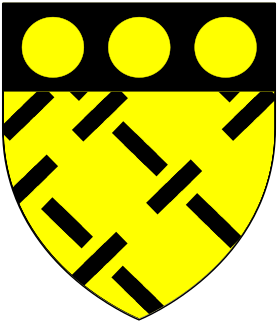
Baron St Amand was a title created twice in the Peerage of England: firstly in 1299 for Amauri de St Amand (1269–1310), who died without issue, when it became extinct; and secondly in 1313 for his brother John de St Amand (1283/6–1330).














